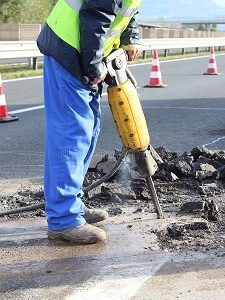How Much Does a Jackhammer Cost?
Last Updated on July 2, 2025
Written by CPA Alec Pow | Content Reviewed by ![]() CFA Alexander Popinker
CFA Alexander Popinker
Shoppers ask about jackhammers for one of the three reasons: budgeting a weekend demolition, quoting a contractor bid, or weighing rental versus purchase for ongoing work. A wrong guess can sink a DIY budget or erode a project’s profit margin. Knowing the real price, base tool, accessories, and hidden fees lets buyers choose the right power tool without overrunning their cost plan.
We cover every angle of the cost equation. You will see market price tiers from $70 (≈4.7 hours to sacrifice at work earning $15/hour) DIY electrics to $1 000+ pro-grade breakers; rental rates by the day or week; line-item extras like $45 (≈3 hours of continuous work at a $15/hour job) chisels and $25 (≈1.7 hours of labor required at $15/hour) vibration gloves; and lifecycle expenses, from maintenance to resale. We also benchmark alternatives—rotary hammers, demolition saws, hired labor—to show when a jackhammer is over-kill or the only sensible option.
Finally, we translate tool-shop figures into total cost of ownership. A cheap jackhammer that fails after one job can be pricier than a premium model with a five-year warranty. The sections ahead break down costs, give live purchase and rental invoices, analyze market trends, and list concrete ways to spend less, so you hit concrete without smashing your wallet.
Article Highlights
- Entry jackhammers start at $70 (≈4.7 hours to sacrifice at work earning $15/hour), pro units hit $1 100.
- Rental rates range $55 (≈3.7 hours of uninterrupted labor at $15/hour)–$95 (≈6.3 hours working without breaks at $15/hour) a day.
- Bits, PPE, and shipping add 10–15 % to purchase totals.
- Pro models last 4-5 times longer than budget imports.
- Seasonal promos and pre-owned deals save 10–40 %.
- Three weekend rentals equal one mid-range purchase.
How Much Does a Jackhammer Cost?
We found three clear price tiers for new jackhammers. Entry-level electric units aimed at homeowners start near $70 (≈4.7 hours to sacrifice at work earning $15/hour) and top at $200 (≈1.7 days working without days off at $15/hour); they deliver 1 200–2 000 W and break patio slabs up to four inches. Mid-range electrics—Bosch, Makita, DeWalt—sit $300 (≈2.5 days of labor continuously at a $15/hour wage)–$400 (≈3.3 days of your career at $15/hour), packing 1 500–3 500 W motors and antivibration handles. Commercial-grade electrics or small hydraulics from Hilti or Husqvarna reach $800 (≈1.3 weeks working without a break on a $15/hour salary)–$1 000+, built for all-day concrete trenching.
Rental cost fills a different bracket. Home-center rates average $55 (≈3.7 hours of uninterrupted labor at $15/hour)–$85 (≈5.7 hours of your life traded for $15/hour) per day, $250 (≈2.1 days working for this purchase at $15/hour)–$300 (≈2.5 days of labor continuously at a $15/hour wage) per week for 35-lb electrics. Heavy pneumatic rigs run $95 (≈6.3 hours working without breaks at $15/hour) daily but require a separate air-compressor rental ($70 (≈4.7 hours to sacrifice at work earning $15/hour) more). Contractors decide buy versus rent based on project count: three four-day jobs per year push rental spend past a $400 (≈3.3 days of your career at $15/hour) ownership buy-in.
Cost directs tool choice. A one-time pool-deck removal leans rental; repetitive sidewalk cuts in a remodel business justify buying a mid-range breaker. Always match rated impact energy (joules) to slab thickness—overspending on power nobody needs wastes hundreds.
According to Tools Advisor, smaller electric jackhammers suitable for light-duty or DIY projects typically range from $200 to $2,000 (≈3.3 weeks trading your time for $15/hour). Pneumatic jackhammers, which are more powerful and commonly used in professional construction and demolition, generally cost between $100 and $1,500 (≈2.5 weeks of non-stop employment at $15/hour). Higher-end or heavy-duty models can cost up to $5,000 (≈1.9 months of your working life at $15/hour) or more, especially for industrial-grade equipment.
This Old House highlights popular electric jackhammers with prices often between $300 and $1,500 (≈2.5 weeks of non-stop employment at $15/hour), mentioning models like the Makita 35-pound demolition jackhammer and Bosch 35-pound jackhammer kit as examples. These electric models are favored for their portability and ease of use in smaller projects.
Pneumatic jackhammers, which require an air compressor, are typically more expensive and heavier. For example, Andy’s Taylor True Value Rental offers a 90-pound pneumatic jackhammer but does not list a fixed price, instead suggesting contacting them for current pricing and availability. Pneumatic models are generally priced from a few hundred dollars to over $1,500 (≈2.5 weeks of non-stop employment at $15/hour) depending on specifications.
Market research reports such as those from Consegic Business Intelligence and IMARC Group indicate that the global jackhammer market is growing steadily, with increasing demand driven by construction and infrastructure projects. While these reports focus on market size rather than unit prices, they underscore the availability of diverse jackhammer types including pneumatic, hydraulic, and electric.
Real-Life Cost Examples
Contractor Purchase – California: Maria’s crew bought a Hilti TE 3000-AVR for $1 125, added two moil bits at $58 (≈3.9 hours spent earning money at $15/hour) each, freight $42 (≈2.8 hours of labor required at $15/hour), and a two-year service plan $179 (≈1.5 days working for this purchase at $15/hour). Final invoice: $1 462. Average runtime so far: 480 hours with only one brush replacement ($32 (≈2.1 hours of your life traded for $15/hour)).
Homeowner Rental – Texas: Greg rented a 15-amp electric breaker from Home Depot for $74 (≈4.9 hours at the office earning $15/hour)/day, used it two days, and paid $32 (≈2.1 hours of your life traded for $15/hour) deposit for bits (refunded). Sales tax made the two-day total $160.50 (≈1.3 days of continuous work at a $15/hour job). He also spent $18 on ear muffs and $9 on dust masks.
Unexpected Repair – Ohio: A small contractor’s $350 Amazon jackhammer lost its SDS-max chuck after 90 days. Parts unavailable; local tool shop quoted $130 labor plus parts. Owner scrapped it and bought a mid-range Makita $389, adding unforeseen expense to a tight quarterly budget.
Cost Breakdown
|
Cost Item |
Entry Electric |
Mid-Range Electric |
Pro Electric |
|
Base tool |
$70–$200 |
$300–$400 |
$800–$1 100 |
|
Bits (set) |
$25–$60 |
$40–$90 |
$90–$150 |
|
Safety gear |
$30 |
$60 |
$80 |
|
Shipping |
$0–$25 |
$0–$40 |
$40–$75 |
|
Service plan |
N/A |
$40–$60 |
$150–$200 |
Bits and PPE add 10 % to 15 % of the total. Shipping grows with weight; many pro models qualify for free freight via distributor promotions. Extended warranties push pro-tool totals higher but cap repair risk on multi-year projects.
Factors Influencing the Cost
Technology type shapes the sticker. Pneumatic or hydraulic systems cost more than plug-in electrics because of compressors and hoses. Brand reputation matters: Hilti commands a 25 % premium over mid-tier names for lower vibration and longer parts support. Power spec drives price; a 45-joule breaker costs roughly 40 % more than a 30-joule sibling.
Market demand peaks in spring construction season; tool-shop promo calendars discount 10 % each December. Tariffs on Chinese cast housings caused a 5 % uptick in 2022 entry-level prices. Regional labor rates influence rental fees—Manhattan shops mark daily rates 20 % above national medians to offset real-estate costs.
You might also like our articles on the cost of concrete saw-cutting, post-construction clean-up, and driveway resurfacing.
Alternative Products or Services
|
Option |
Price |
Strength |
Best Use |
|
Rotary hammer |
$120–$600 |
Low |
tile, small holes |
|
Demolition hammer |
$180–$450 |
Medium |
3-4 in slabs |
|
Sledgehammer |
$30–$60 |
Manual |
thin patio, brick |
|
Hire demo crew |
$7–$10 sq ft |
High |
heavy footings |
|
Jackhammer rental |
$55–$95 day |
High |
weekend demo |
 Rotary hammers save money where slabs under four inches suffice. Sledgehammers beat any powered cost when labor is free and concrete thin. Hiring a demo crew removes tool headaches but raises total project price; quotes hit $2 000 on a typical 200-sq-ft patio.
Rotary hammers save money where slabs under four inches suffice. Sledgehammers beat any powered cost when labor is free and concrete thin. Hiring a demo crew removes tool headaches but raises total project price; quotes hit $2 000 on a typical 200-sq-ft patio.
Ways to Spend Less
Our data shows seasonal clearance in December slashes 15 % off mid-range electric breakers. Contractors save another 10 % via vendor loyalty tiers; hitting $5 000 annual spend triggers bulk discounts. Certified pre-owned pro tools list at 60 % of new, provided hour meters stay under 300. Rental houses run 4-for-3 deals on weekly bookings—ideal for staggered renovation phases.
Buying once-used bits from auction sites trims consumable costs by half. Finally, price-match guarantees at big-box stores let DIYers bring down the in-store price if an online seller lists a lower advertised rate.
Expert Insights
- Jim Carter, ToolFleet manager: “Pay attention to impact energy, not amps. A $300 35-joule unit often beats a $450 28-joule model in productivity.”
- Laura Kim, OSHA trainer: “Invest $40 in antivibration gloves; medical downtime costs more than any tool.”
- Hank Diaz, Rental Ops Director: “If you rent three times in six months, you’ve crossed the ownership threshold—buy mid-range and resell later.”
Answers to Common Questions
How powerful should my jackhammer be?
Match impact energy to slab: 20–30 joules for thin patios, 45 + for footings.
Is electric or pneumatic better?
Electric suits most DIY and mid-pro jobs; pneumatic excels only with existing compressors and all-day duty.
Do I need special circuits for high-amp models?
Yes. Tools above 15 amps draw too much for standard 120-V outlets; use 20-A circuits.
What maintenance does an electric jackhammer need?
Regular brush checks, grease lube every 50 hours, and bit shank cleaning.
Can I return a rental early for a refund?
Most shops prorate unused days minus a one-day minimum—confirm before booking.

Leave a Reply
Want to join the discussion?Feel free to contribute!